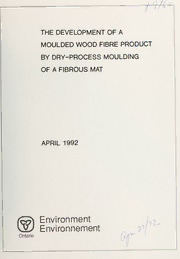
The Development of a moulded wood fibre product by dry-process moulding of a fibrous mat PDF
Preview The Development of a moulded wood fibre product by dry-process moulding of a fibrous mat
L^ -h=^ THE DEVELOPMENT OF A MOULDED WOOD FIBRE PRODUCT BY DRY-PROCESS MOULDING OF A FIBROUS MAT APRIL 1992 Environment u-j^ Environnement f Ontario {\. ISBN 0-7729-9569-9 THE DEVELOPMENT OF A MOULDED WOOD FIBRE PRODUCT BY DRY-PROCESS MOULDING OF A FIBROUS MAT Report Prepared For: Waste Management Branch Ontario Ministry ofthe Environment and Fibre Control Inc. Report Prepared By: Forintek Canada Corp. APRIL 1992 o PRINTEDOK RtCYOB)PAPER IMPRIMCSUO DUPAPIERRECrCli Cette publication technique n'est disponible qu'en anglais. Copyright: Queen's Printer for Ontario, 1992 This publication may be reproduced for non-commercial purposes with appropriate attribution. PIBS 1916E DISCLAIMER This report was prepared for the Ontario Ministry ofthe Environment as part ofa ministry- funded project. The views and ideas expressed in this report are those ofthe authors and do not necessarily reflect the views and policies ofthe Ministry ofthe Environment, nor does mention oftrade names or commercial products constitute endorsement or recommendation for use. TABLE OF CONTENTS Page 1.0 OBJECTIVES 1 2.0 INTRODUCTION 1 BACKGROUND 3.0 1 4.0 MATERIALS AND METHODS 5 4.1 DESIGN AND FABRICATION OF PALLET-TRAY MOULD 5 4.2 SELECTION OF A COMMERCIAL FIBRE MAT 5 4.3 TEST SERIES I 6 4.4 TEST SERIES H 6 4.5 FULL-SIZED PALLET-TRAY MOULDINGS 6 4.6 PALLET REDUCTION MACHINERY 7 4.7 PALLET TESTING 7 5.0 RESULTS 7 5.1 TEST SERIES I 7 5.2 TEST SERIES U 8 5.3 FULL-SIZED PALLET-TRAY MOULDINGS 8 5.4 PALLET TESTING 8 6.0 CONCLUSIONS 9 APPENDIX I WOODWASTEREDUCTIONMACHINERYFORTHEPRODUCTION OF WOOD CHIPS APPENDIX n TEST PALLET DETAILS APPENDIX ffl TEST METHODS OBJECTIVES 1.0 To demonstrate a dry process, moulded fiberboard technology that could be used to convert discarded wood pallets and similar wood wastes into saleable products. . Toidentify and assess wood wastereduction machinery to convert wood pallets to chips. Todesign and fabricate apallet-tray forthe stable transport oftote boxes in the . auto industry. To produce pallet-trays and mount them on pallets for field testing in the . industry. , To test different types ofpallets with trays attached. INTRODUCTION 2.0 Solid wood waste from manufacturing industries and other sources such as building construction, renovation and transportation has been estimated atup to 1 million tons per year in Ontario. Because of the bulk and form of these wastes, it is becoming increasingly difficult to dispose of solid wood in municipal dumps. Many dumps no longer accept wood, and alternative solutions are not easy to find. In the auto industry, softwood pallets used for the shipping and handling of parts, present a major waste disposal problem. The volume of wood associated with these pallets is very large and the economics do not favour the reuse ofthese low cost "one- way" items. However, in relation to many other wood wastes, the auto industry pallet has the advantage ofbeing relatively consistent and free ofcontamination by otherwaste materials. This makes the logistics of collection and processing much more attractive in any attempt to find alternate uses. BACKGROUND 3.0 Moulded wood-fibre products In 1963, Wayerhaeuser Co. became the first company to manufacture large volumes of mouldedwood-fibredoors. The technologydevelopedvery slowly, with Masonite Corp. andJeld Wen Corp. establishing manufacturing facilities in the 1970's toproduce similar door products. It was not until the early 1980's that the term "advanced wood-fibre composite" was recognized. This new product is a wood-fibre-composite containing two or more materials in addition to wood fibres. It was developed to improve mechanical and physical properties such as stiffness, strength, toughness and dimensional stability. With these improved properties researchers began to consider new applications. The properties of "advanced wood-fibre composites" can be tailored to product requirements. The mechanical and physical properties are controlled by the amount of wood fibres, resins and synthetic reinforcements used as well as the processing parameters applied in the moulding stage. An endless number ofshapes and forms can be produced with the proper blend of components. Wood fibres Wood fibres remain one ofthe cheapest raw materials for the production ofcomponents and have distinctive characteristics such as heat stability, non-rusting nature and high strength for relatively low weight. The introduction ofadvanced wood-fibre composites is one of the more significant developments in the long history of the wood industry. It could stop or reverse the loss of traditional wood markets to the plastics and steel industries in such areas as; housing, recreational materials, automobiles, packaging and transportation. Softwood and hardwood in the form of roundwood, slabwood, forest thinnings and sawmill and factory residues can be used. The resource is first converted to chips which are screened and treated to remove any foreign materials. The chips are steamed under pressure then forced through a narrow gap between rotating discs of a refiner. This separates individual fibres or fibre bundles firom the softened wood chips. The wet fibres are then dried with a high velocity hot air source and collected in a cyclone. The wood fibres at this stage are very bulky and require large selfunloading storage bins. Resins Cadhesives') Resin technology for moulding applications is still developing. Phenol formaldehyde resin appears to be the most suitable adhesive for most moulded fibre products. It is widely used in the wood products industry and can offer a wide range ofproperties. It is relatively inexpensive and canbe chemically modified toreact with certain reinforcing fibres. A numberofspecially designed phenol formaldehyde moulding resins havebeen tested for intricate moulded products. Reinforcements and additives Reinforcements provide certain mechanical properties to the composites which are not easy to achieve firom wood fibres alone. The most widely used reinforcements in advanced composites are: • glass fibres • aromatic polyamide fibres containing para-oriented linkages (Kevlar) • graphite • boron They are available in a variety offorms:
